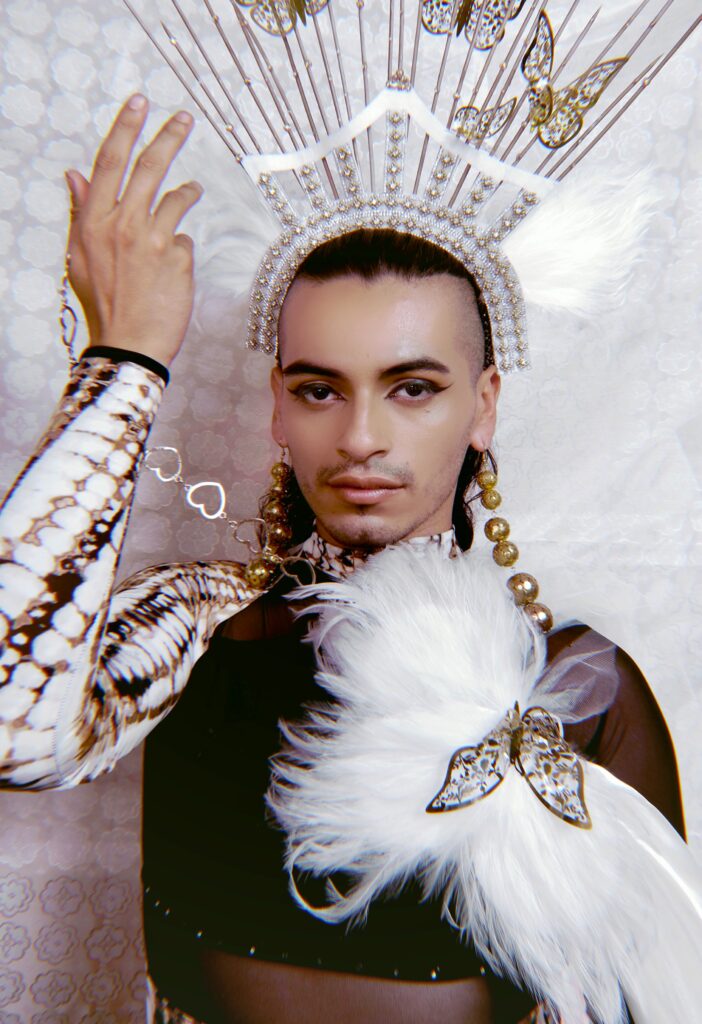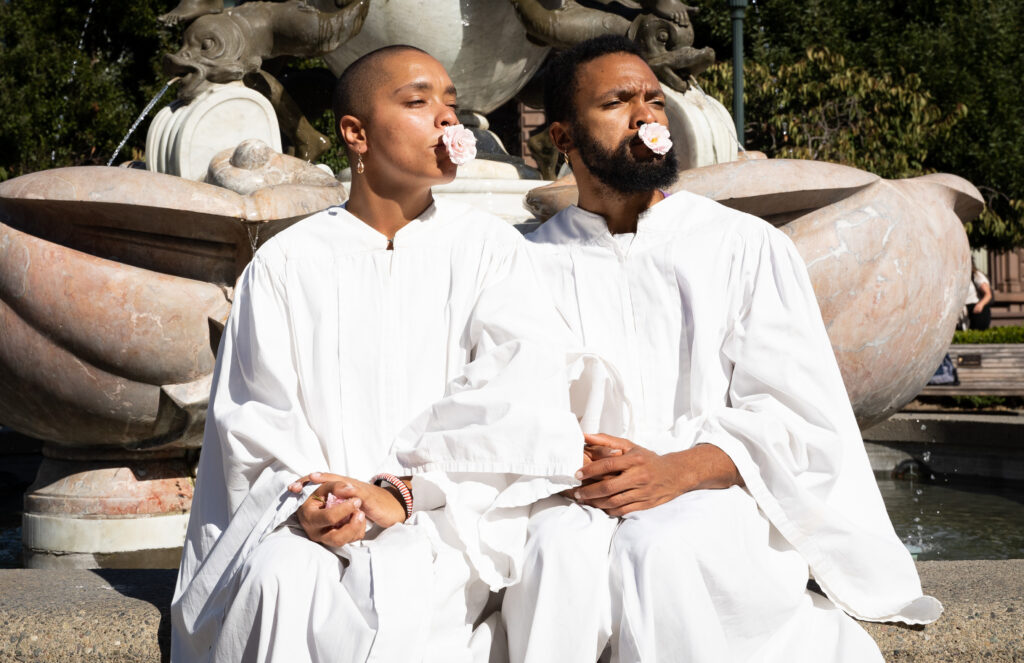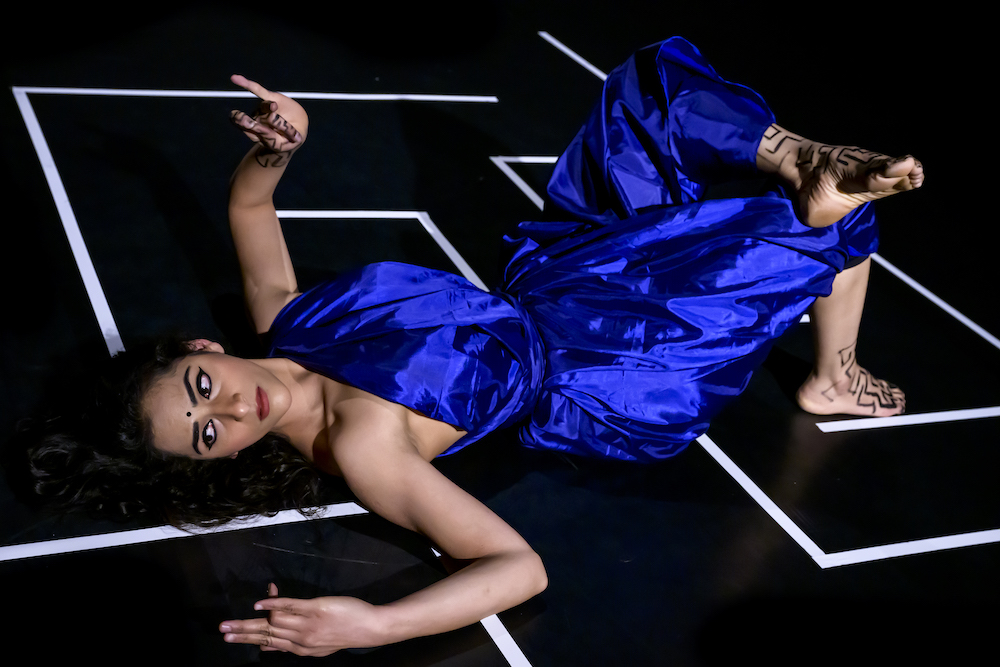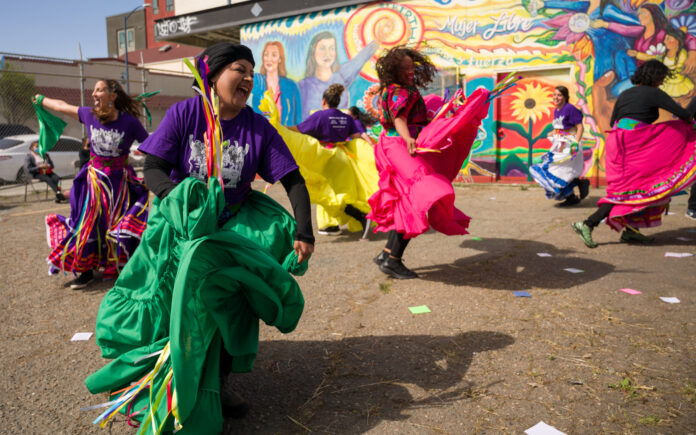Of course, my tape recorder wasn’t turned on for the beginning of a 48hills phone interview with organizers of this year’s D.I.R.T. [Dance In Revolt(ing) Times] Festival, which runs April 15-23 at Dance Mission Theater. But in those forever-transcript-less moments, Dance Mission Executive Director Krissy Keefer spoke of the biennial event’s first iterations a decade and a half ago. Back then, she said, explicitly political dance performance was less prevalent. But D.I.R.T. groundbreakers like José Navarrete—whose NAKA Dance Theater returns this year for a collaboration with Mujeres Unidas y Activas—and Keith Hennessey took the stage with purpose and fury, the latter unfurling a US flag while referencing Mark Twain’s incisive anti-imperialist commentary on the 1899-1902 Philippine–American War.

Such historical context matters because this year, D.I.R.T.’s 16 contributing artists and community collectives will bring visions of the local and global issues of 2023 to the stage. Its three programs will focus on disastrous Supreme Court decisions like Roe vs. Wade’s revocation, the throttling of environmental protections, and the defanging of judicial power when it comes to gun control laws—and go beyond, into foundational issues the court is also addressing like LGBTQ and immigrant rights.
Keefer and managing director Stella Adelman will present an intensely personal piece called “The Abortion Monologues” as part of April 15 and 16’s program. In our interview, they spoke of the festival’s evolution, and what, exactly, can be the goal of “message art” in a bewildering, disillusioning 2023. The following transcript begins when I got my life together and turned on the recorder. It’s been edited and condensed.
48HILLS I think it’s interesting this point you made, Krissy, about how 15 years ago there wasn’t as many explicitly political dance pieces, whereas that is not the case now. How has this increasing popularity of—I would call it—”message art” affected how these themes are presented in the dance pieces that are part of this year’s D.I.R.T. Festival?
STELLA ADELMAN It’s like, how do we get more specific in what we’re saying, and really focusing on what the point is? Is it just to keep people engaged, to have an emotional response so that they then become more active citizens? But, there’s a time for people to come together and be in healing space. That has really been something that folks have really needed and appreciated in these times. There’s also the issue of whose voices are you—it’s weird to be a curator, because you kind of end up being these weird gatekeeper, which has its own problematic things in and of itself, and is something that you’re always trying to interrogate and figure out. But: what voices are being highlighted that maybe haven’t been, because of historical issues? That was really not quite an articulate answer—
48HILLS Points were made.
KRISSY KEEFER I was having a conversation with a friend, and I was saying, “What’s the point, at this point?” I mean, I did a piece on climate catastrophe called “Butterfly Effect” right before the pandemic. And I said, “I could run that piece for a year and it’s not going to make any difference about the climate.” She said, “But that’s not the point. The point is when we get together and we see the work, we get reinspired and re-invigorated, and we begin to have faith that we are connected.” Not even that we’re going to get out of this mess, you know, but that we are connected in a mutual struggle.

STELLA ADELMAN I really felt that with Dance Brigade’s 40th anniversary production at YBCA, which they held right before Trump’s inauguration. That show gave so much. The point of it, and of being in that space at that time, was in looking around at each other. Like, “OK, there’s people here who we can call on.” We’re going to be OK, not because we’re going to be complicit, but because there’s people who have our backs. We can do this together. I was like, “Oh, this is why we do art.” It was a nice reminder of the gathering, of the coming-together, of having the shared experience to get reinvigorated.
Help us save local journalism!
Every tax-deductible donation helps us grow to cover the issues that mean the most to our community. Become a 48 Hills Hero and support the only daily progressive news source in the Bay Area.
48HILLS This year’s edition carries the theme of “Citizen SUPREME,” and asks participating artists to formulate responses to hellacious Supreme Court decisions that have been coming down. It seems like such a tall order, to find a citizen response to this massive legal institution’s bilateral decisions about our lives. Were people able to find such avenues to community empowerment in the face of these Supreme Court decisions?
KRISSY KEEFER There’s three issue that we’re focused on: choice—the abortion issue—gun control, and the environment. And people are rallying, making work around choice, and often from a kind of personal point of view.
STELLA ADELMAN Those are the three issues that we focus on, but some other folks are talking about LGBTQ rights and immigrant rights, because those are also issues that are going through the court system. We always think of the courts as this “other thing,” like they’re the ones who will tell us what our morals are as society. But through what’s happening now, we see it’s actually super-systematic thing that we do have control over, starting with the lower courts, which is who you vote for. The Supreme Court is not this untouchable thing, we do have power over it, we do have say over it.

48HILLS Including pieces around immigration, considering the theme, seems very on-point. “Citizen SUPREME”—like, what does “citizen” even mean in this context?
[In response to this question, Adelman sent me the following email from Emma Quan Dewey, whose piece runs in D.I.R.T. Festival’s Program B April 22 and 23.]
EMMA QUAN DEWEY “Crazy American” is an embodied exploration of my mother’s family migration history from South China to the Philippines to the US, and how it places me and my family within structures of US imperialism, racial hierarchies, and Chineseness itself. My family’s migration path occurs through a highly-specific (and historically ignored) prism of American overseas empire, since the Philippines was a US colony from 1898-1946, more or less the years that my family lived there. Our history, of transition from US colonial subject to US citizen, presents a unique opportunity for understanding a form of Chineseness developed in deep and ongoing relationship to US empire and racial hierarchy. “Crazy American” examines the intimate ways these structures play out at the level of the body, and seeks to imagine new possibilities for moving through systems and stories of power, disrupting monolithic narratives about what it means to be Chinese in the US. D.I.R.T.’s theme this year of “Citizen SUPREME” prompts me to ask what it takes to transcend the boundaries of citizenship, its bureaucratic constrictions and definitions made to serve systems of power. To me, that answer lies in a deepened and clarified spirituality, that allows one to experience the full scope of one’s humanity, as a being deeply interwoven into a broader ecology of other spirits, past, present, and future.
48HILLS I would also love to hear about the collaboration process that created the Andreína Maldonado–California Domestic Workers Coalition piece in this year’s D.I.R.T.
STELLA ADELMAN In 2018, Dance Mission Theater started working with Andreína Maldonado, who is a fantastic artist, along with la Colectiva de Mujeres, another domestic workers coalition that is based in the Mission District. When you do domestic work, you’re alone in the house, you’re often isolated. Because it’s not the “traditional workforce,” you don’t often have worker protections in terms of what cleaning supplies you’re using, pay issues, pay theft. Sexual abuse can happen, because you’re alone in the house, and you might be afraid to speak up because of your immigration status, or for other reasons.
So Dance Mission, Andreina, and la Colectiva de Mujeres started offering dance classes as a form of wellness, a way to be in your body—especially since domestic work is so physical. You’re working with elder care, you’re moving bodies—or infant care, as well as cleaning. From that, [dance class participants] were like, not only do we want to move, we want to tell our stories. The project expanded to [encompass] story-telling through text and movement, and to working with the California Domestic Workers Coalition, who work with a larger swath of folks, not just on an uber-local basis in the Mission. In September, Andreina put together a show at Dance Mission called “Our Work, Our Dignity.” It was in Spanish with English supertitles projected. She’s taking that project and expanding on it, and showing a different section of it for the D.I.R.T. Festival.

48HILLS Let’s talk about “The Abortion Monologues.” This seems like a very pointed response to the call that has gone out to center the voices of people who have chosen to terminate their pregnancy in the middle of this virulent, horrible debate that’s going on around abortion rights. I’m just wondering how does this play makes that case for centering these voices? What do we learn from listening directly to the voices of people who have had abortions within this piece?
STELLA ADELMAN “The Abortion Monologues” is actually something that Krissy and I are working on. I have been conducting a series of interviews of people who’ve had abortions. We’ve edited them together for D.I.R.T., and Krissy’s directing the production. Four actors are telling four different stories, which are interwoven—you can follow each one separately, and then they come together at the end.
The idea was, “How do we normalize this experience as health care, and take the stigma out of it?” It’s interesting, because I put out a call [for interviewees] and so many people responded, some saying, “Nothing really happened—it wasn’t like I had this trauma, but I really want to talk about it. No one ever asks me about my abortion.” Other people were like, “I didn’t have an abortion, but I had a miscarriage, and I want to talk about that.” The stories come from people of all different ages. Some people had them pre-Roe and in the South, and then other people had them here in San Francisco through Planned Parenthood when it was very legal. Others’ were a result of rape, for others it was just an accident with their partner. We’ve framed the piece with the voice of Justice Sonia Sotomayor to kind of give us some contextualization for today.

KRISSY KEEFER Everybody comes at [abortion] with such a different point of view. The thing that I keep trying to push for is that you shouldn’t have to process a million and one feelings about it, unless you want to. There’s so much guilt and there’s so much shame. The right wing in the last 30 years has done such an amazing job [of stigmatization that] that it’s even hard to say, “I had an abortion.”
Someone like me, who had an abortion when they were 16, has gone from that trauma when they were not legal, to the current day when there’s the after pill and multiple ways to actually terminate a pregnancy or stop a pregnancy from happening. That was never available to me [when I was young]. If you were having sex at 16, you were likely to get pregnant. You were stigmatized for having sex, and then you were stigmatized for getting pregnant. [When I was that age], we were all supposed to find the one person, get married, and stay with that person, blah blah blah. This dives into women’s liberation. [Opponents of abortion rights] don’t want women to be able to have control over their own lives. It’s a fucking life choice, stay out of it, it’s none of your business!
48HILLS Right?
KRISSY KEEFER It’s so crazy. But what’s interesting is that now the people are deciding. All these states, like Wisconsin and Kansas that you’d think are traditionally fundamentalist Christian and conservative, are all voting [to protect the right to an abortion]. You know, all these families, their kids are having sex! Everybody’s having sex! Sex is everywhere in our culture at this point. Everybody’s fucking day in and day, out all day long! So everybody gets pregnant, and everybody wants to be able to terminate a pregnancy. That’s just bottom line. They’ve hijacked it, and made it into this thing “that the majority wants.” But when the majority votes, they actually vote for [people who have abortions] to be able to keep their rights.
STELLA ADELMAN Yeah, and also let’s just take a second and recognize that the Hyde amendment, which took away the right to have federal funding to fund abortion care, passed [back in 1976.] That made it nearly impossible for poor women and other people who are pregnant to have abortions. Now because [modern-day abortion bans are] coming for everyone, it’s more in the news. But we should have been [fighting back against abortion restrictions] a long time ago.
I had an abortion too. It was interesting for me—any time I talked about it, I felt like I had to really be careful with my words. “Someone’s going to use this for propaganda for either way.” If I say that it was hard, then people who are anti-choice are going to use that. If I say that it was easy, you know? Then it’s going to be used this other way. How could I just say that this is how I experienced it? That was also one of the ideas of “The Abortion Monologues”: how can you have people share their experience without being scared that it’s then going to be used for some kind of propaganda machine? These stories are ours.
48HILLS Are your personal experiences included in the finished piece?
STELLA ADELMAN Mine is.
D.I.R.T. FESTIVAL April 15-23, $58 all three programs, $22-27 single program. Dance Mission Theater, SF. Tickets and more info here.





